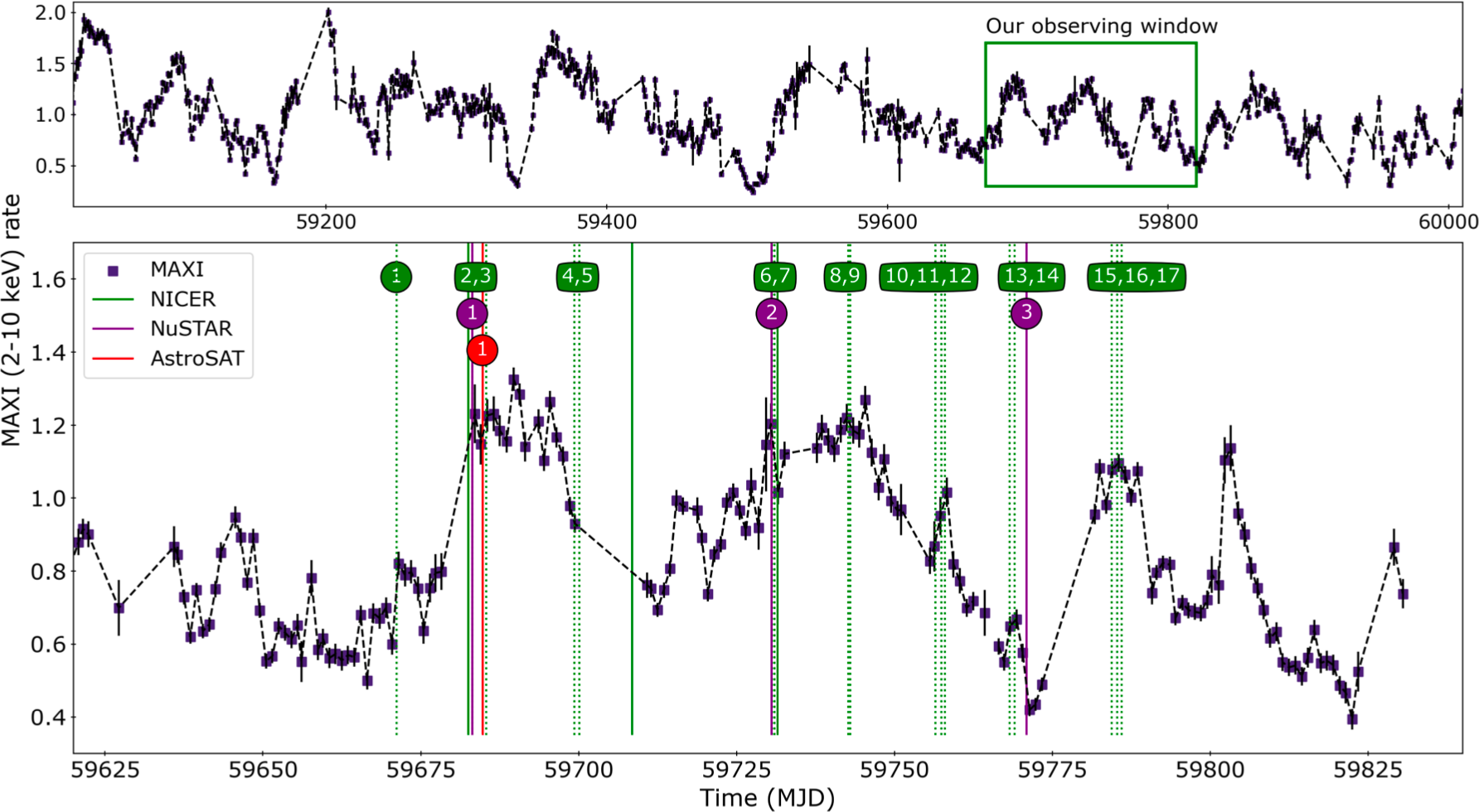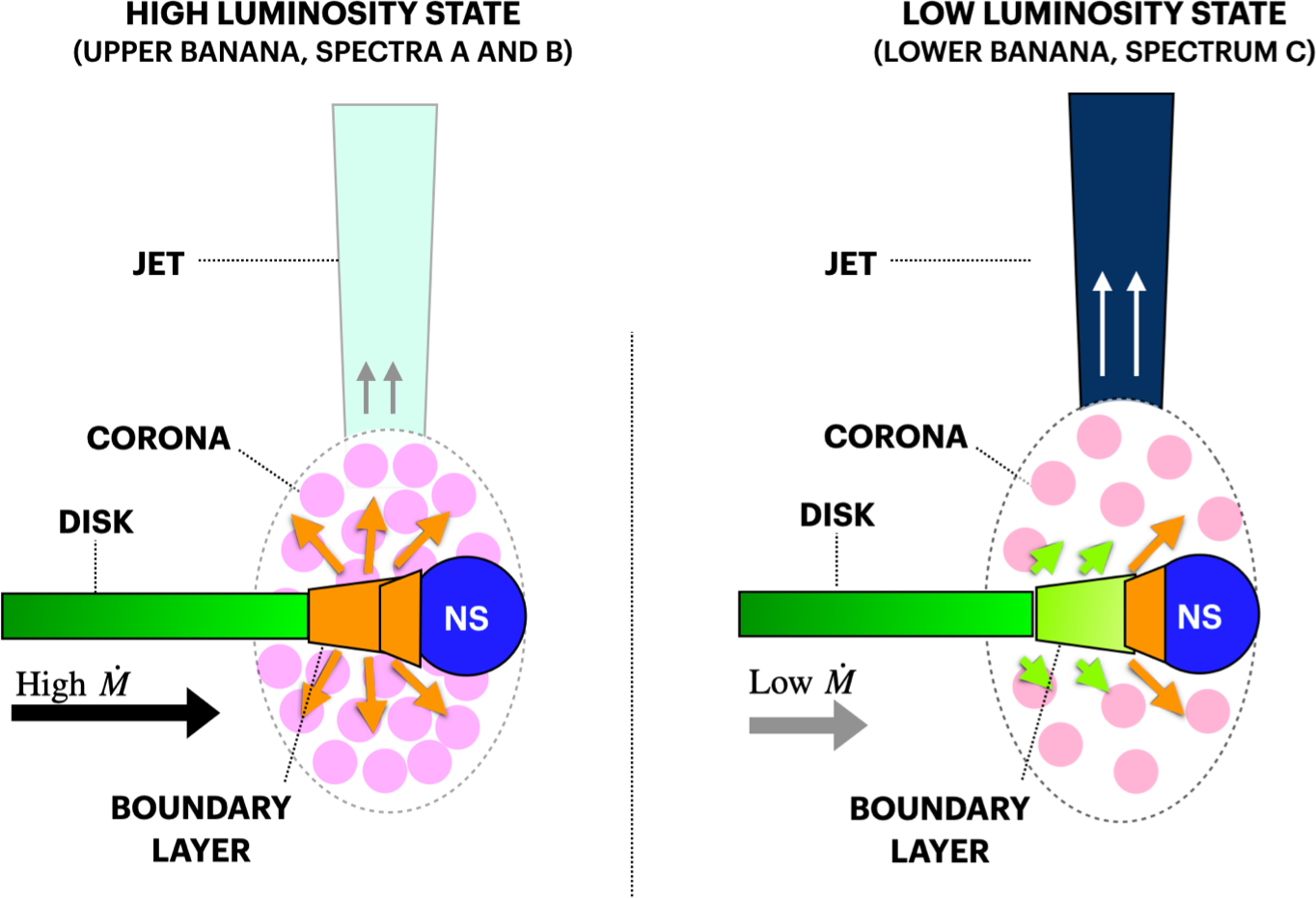NICER / ISS Science Nugget
for October 5, 2023
Matter in, matter out
Accretion in stellar systems -- the flow of matter driven by a star's gravitational pull -- is common but also diverse in the structures and processes that it produces. Complex interactions between matter, radiation, and strong gravity are responsible for this diversity, and much depends on the nature of the accreting body: whether it has a surface and perhaps a strong magnetic field (e.g., a neutron star), or whether the flow encounters only an event horizon (a black hole). It has long been known -- through direct imaging, for example -- that some of the infalling matter is ultimately channeled into jets, powerful streams of particles that are ejected from even the deep gravitational wells of black holes. An understanding of the origin of these jets, the mechanism(s) responsible for launching matter near the speed of light, has remained elusive for decades. While the accretion flow glows in X-rays, jets shine in radio and infrared light, so that attempts to discern any correlation between accretion and jet formation require coordinated multi-wavelength observations.
In Cycle 4 of NICER's General Observer (GO) program, a team of scientists observed the neutron-star binary system 4U 1820-30 with a trio of X-ray telescopes and the Australia Telescope Compact Array at radio wavelengths. An ultracompact binary, 4U 1820 has the shortest orbital period, 11.4 minutes, of any known binary hosting a neutron star or black hole, and it is a persistent, "always on," source of X-rays, as the neutron star draws matter from its companion white-dwarf star. 4U 1820 also exhibits a 170-day "super-orbital" period in its X-ray brightness and spectrum, and past sporadic observations had hinted at changes in its radio (i.e., jet) emission across the repeating 170-day interval. Sampling a single super-orbital interval, the GO team set out to track variations in the X-ray and radio properties to search for correlations. The results were somewhat surprising, running counter to behavior observed frequently in black-hole systems: the jet was brighter when the X-rays were dimmer, and vice versa, specifically following variations in the X-ray emission of high-temperature regions closest to the star -- the ionized "corona" and the boundary layer between the accretion disk and the stellar surface -- but not the accretion disk itself. The team proposes a model in which this anti-correlation arises because, at high accretion rates corresponding to high disk luminosity, the boundary layer pumps large numbers of photons into the corona, where electrons lose energy in up-scattering those photons and become cooler. Conversely, few photons are available from the boundary layer at low accretion rates, so the coronal electrons remain energized and hot. In this model, then, the jet brightness tracks the temperature and plasma energy available in the corona. The paper describing these results and interpretations was recently published in the peer-reviewed UK journal Monthly Notices of the Royal Astronomical Society by A. Marino (Institute of Space Sciences, Spain) and collaborators.


Left: The top panel shows long-term X-ray brightness, in photon counts per second, of the neutron-star binary 4U 1820-30 as measured by JAXA's MAXI payload on ISS between June 2020 and June 2023. Detail within the green-box interval (April to September 2022) is provided in the lower panel, where observations with NASA's NuSTAR telescope, India's AstroSAT, and NICER are indicated with colored and numbered vertical lines. These coordinated observations in X-rays were accompanied by coverage at radio wavelengths, from Australia, on three days (Credit: A. Marino, et al. 2023).
Right: Illustration of accretion in a low-mass neutron-star binary. An accretion disk (partially shown edge-on at left in green) directs matter into the near environment of a neutron star, reaching its surface through a transition, or boundary, layer. The thin, energetic plasma of the corona is illuminated by emission from the boundary layer, with implications for the properties of the jet that likely is rooted in the corona: counterintuitively, the jet (dominant in radio and infrared) is seen to brighten at lower accretion rates (right panel), when the boundary layer injects less energy into the corona. The overall luminosity, predominantly in X-rays, tracks the rate of mass flow (M-dot); both are high in the left panel (Credit: A. Marino, et al. 2023).
<< Previous
Main Index
Next >>